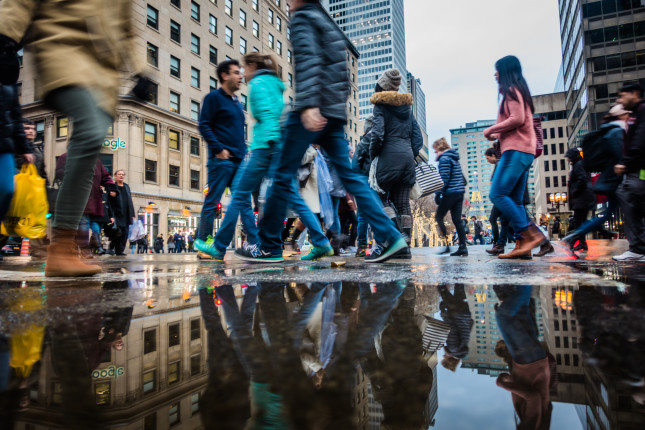-
Why Cities Matter
March 15, 2021 By Blair A. Ruble
Do you remember a year ago when many of us traveled regularly? Do you remember the experience of flying into a major city somewhere in the world, picking up your bags in a modern airport (that probably functioned more efficiently than in the United States), and getting a vehicle to take you downtown? After leaving the airport, we would often drive past miles of informal settlements—self-built shelters unkindly called “slums” much of the time. We may have even found ourselves asking why local authorities “don’t do something” about them.
The difficulty is that we assume informal settlements to be local problems reflecting local dysfunctionality. They of course take the shape they do in part due to local factors such as land laws, inequality, and labor markets. Nonetheless, with more than one billion people living in informal settlements on nearly every continent, we must recognize that what we often consider a local problem is a global phenomenon that is shaping life everywhere on the planet, as much as new technologies, migration, and climate change.
An initial impulse might be to try to prevent people from leaving the countryside for the planet’s sprawling metropolitan centers. Ever since farmers started moving into the world’s first city of Uruk 6,000 years ago, and despite the hardships all-too-often involved in gaining an urban toehold, cities remain places of promise. Cities hold the possibility of hitting life’s lottery no matter how slowly policies may come into effect to help populations adjust to burgeoning urban growth. This is particularly the case in the rising medium-sized cities of between five and ten million residents, where urban growth is primarily occurring. Even without rural to urban migration, cities are guaranteed to expand through natural population growth.
Recognizing that urbanization trends are likely to continue for society, how can we begin to come to terms with urbanization on a global scale? The challenges of urbanization are no less troublesome than coming to terms with the other 21st century driving forces of change. But while these massive changes have entered the daily lexicon of everyday life, metropolitan sprawl remains underappreciated.
If we study how medium-sized cities are developing, we can begin to think holistically about how to craft policies which plan ahead. Transportation for the populations living on the outskirts of cities and working downtown will be essential. Sanitation services—as the COVID-19 pandemic makes clear—must be safely managed if people are expected to live in high-density urban areas. Job creation, housing, food security, gender equality, land use, and the like will all be critical for cities aiming to usefully bend the curve towards a more benevolent future.
Getting to a point where we can think holistically about cities and how to meet the diverse needs of the people who live there won’t be easy, but cities still hold the inspiring possibilities of a better future. Getting cities “right” will help us respond more efficaciously to other hallmarks of twenty-first century tumult, such as advances in artificial intelligence and biological technology, migration, and climate change. Ultimately, this means planning cities for those who have not yet migrated.
Such plans need not be particularly utopian. An excellent model for what needs to happen is the 1811 Commissioners’ Plan for New York City, which planned the now-famous Manhattan grid at a time when the island was largely unpopulated. Similarly, architect Ildefons Credá designed a massive expansion of Barcelona at the end of the nineteenth century. Credá’s now-iconic Eixample established an ambitious street grid in which the intersection of wide avenues and smaller streets formed octagonal blocks with chamfered corners to maximize light and ventilation. This expanded city filled in over the early years of the twentieth century, one building and one block at a time. Both New York and Barcelona demonstrated the wisdom of recognizing more residents will arrive and setting out a thoughtful, integrated plan for shaping their settlement before they arrive.
Some cities around the world have attempted to plan for the future development of vacant land on a smaller scale. One dramatic, large-scale example may be seen in Dubai upon assuming leadership of Dubai. Sheikh Rashid bin Saeed Al Makoum commissioned John Harris to do what the Commissioners had done in Manhattan, and Credá had achieved in Barcelona: plan a city for people who had not yet arrived. Harris’s vision of organized zones and a town center connected by an extensive road system set down the basis for a giant and unprecedented Dubai.
Cities are important to our future precisely because they are the places where global trends converge. Like the great visions for Manhattan, Barcelona, and Dubai, we now need a global revelation. We need to be forward-thinking, planning for our future cities which we’ll one day fly to and from. It is not too late to ensure that cities become genuine places of promise by nurturing and planning a holistic view of the city.
Blair A. Ruble is a Distinguished Fellow at the Wilson Center, where he previously held several positions including Vice President for Programs. He is the author of seven monographs and co-editor of more than a dozen volumes examining the importance of cities for our future. His most recent monograph, The Muse of Urban Delirium, appeared in 2017.
Sources: Cities Alliance, “Showpiece City” by Todd Reisz, The Greatest Grid, “The Life and Death of Ancient Cities” by Greg Woolf, The Guardian, United Nations, United Nations Human Settlements Programme, World Resources Institute.
Photo Credit: People walking fast during shipping hour on Ste-Catherine Street in Montreal, Canada, courtesy of Benoit Daoust, Shutterstock.com.
 A Publication of the Stimson Center.
A Publication of the Stimson Center.



